Abstract
Although the supply of physicians in the United States has doubled during the past 20 years, there is still disagreement as to whether we currently have or should expect a significant surplus of physicians. The evidence suggests that despite the rapid expansion in the pool of available physicians, serious physician shortages persist for certain rural populations, ethnic and occupational groups, and other medically disadvantaged segments of the population. Medical students' declining interest in rural practice and primary care specialties suggests that problems of geographic and specialty maldistribution may worsen despite a rising population of physicians. It is unlikely that a significant physician surplus will develop unless there is a conscious attempt to limit the proportion of national wealth expended on medical care. Pockets of shortage can be reduced by broadening the availability of health insurance, lessening large income disparities between different specialties, changing the way teaching institutions are reimbursed for their training costs, and supporting direct governmental service programs such as the National Health Service Corps.
Full text
PDF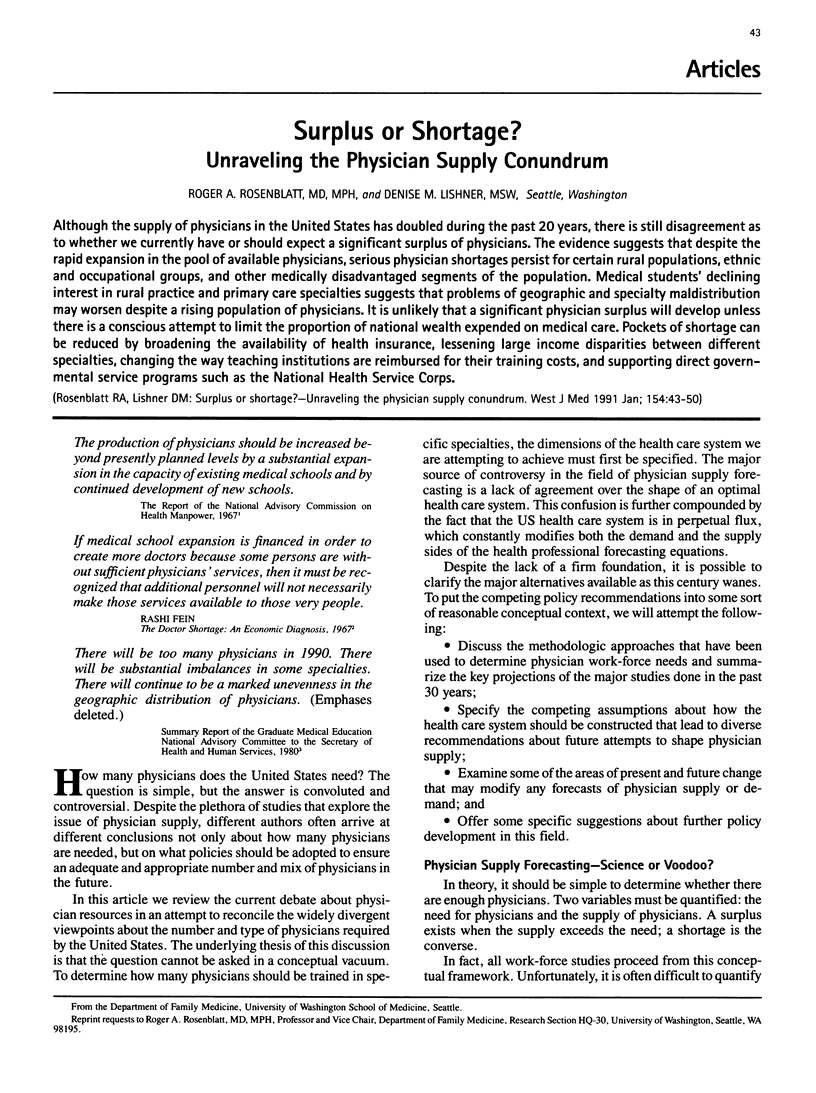

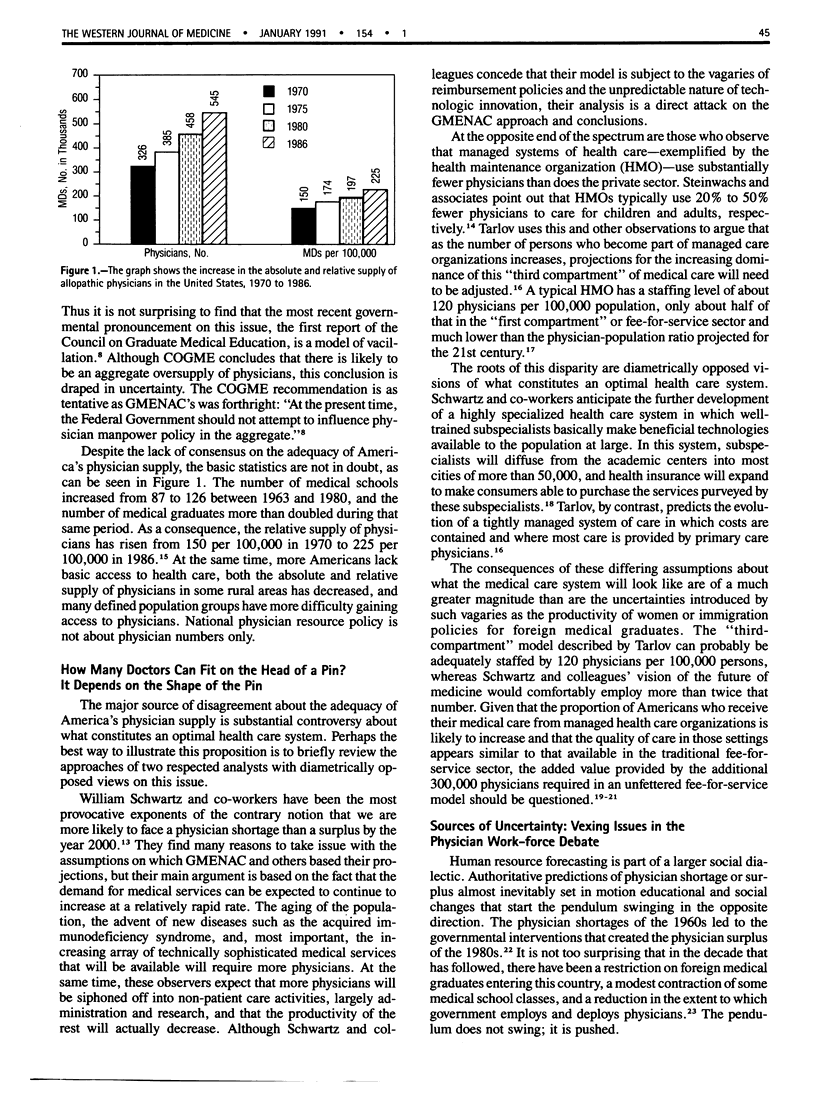
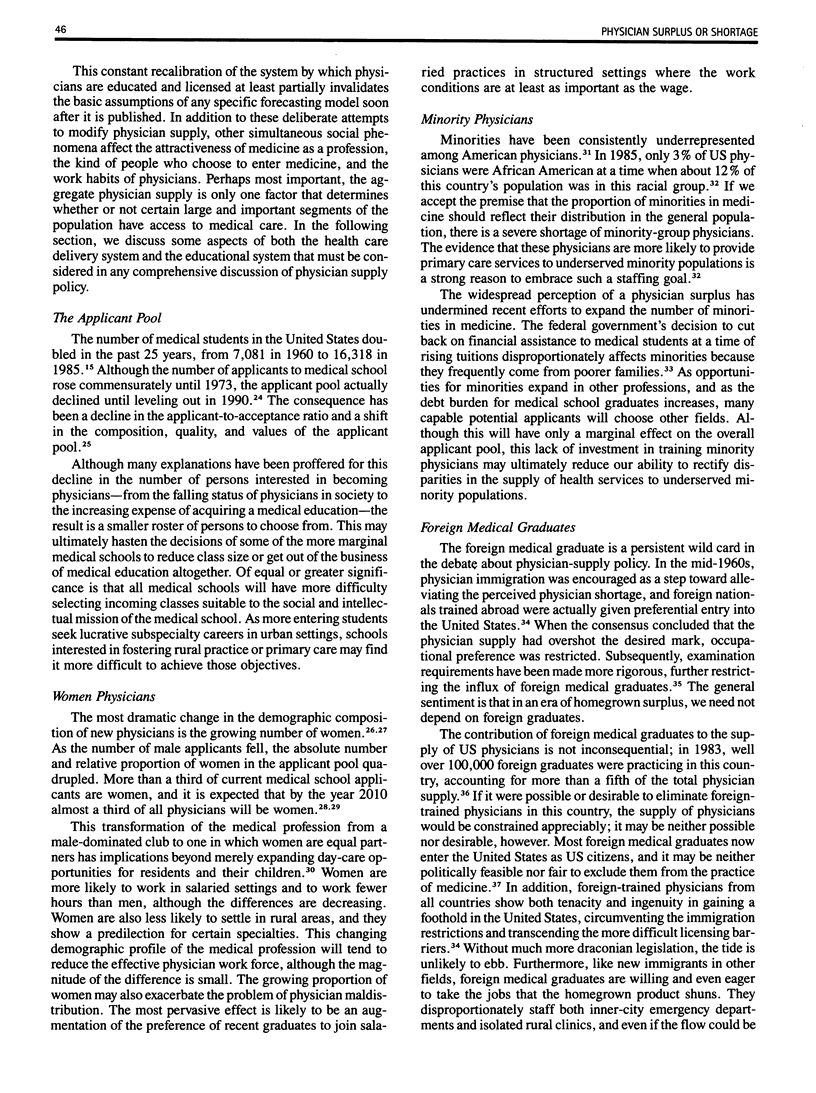
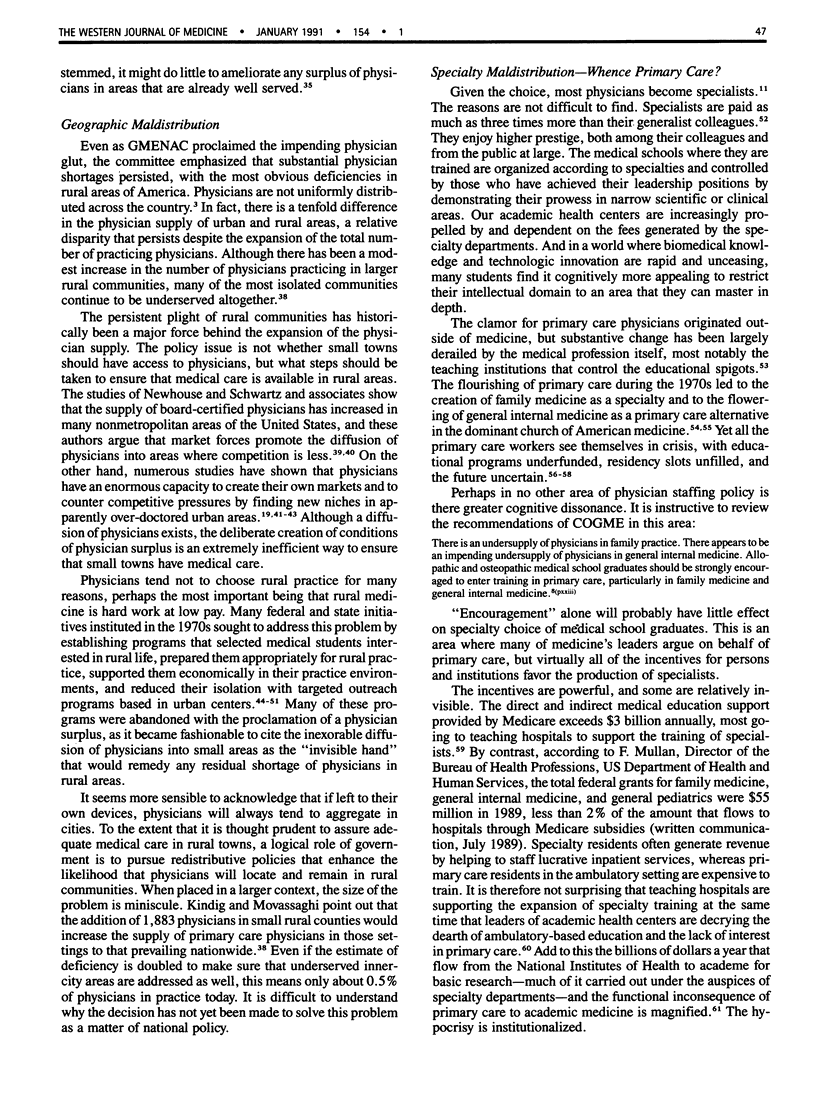

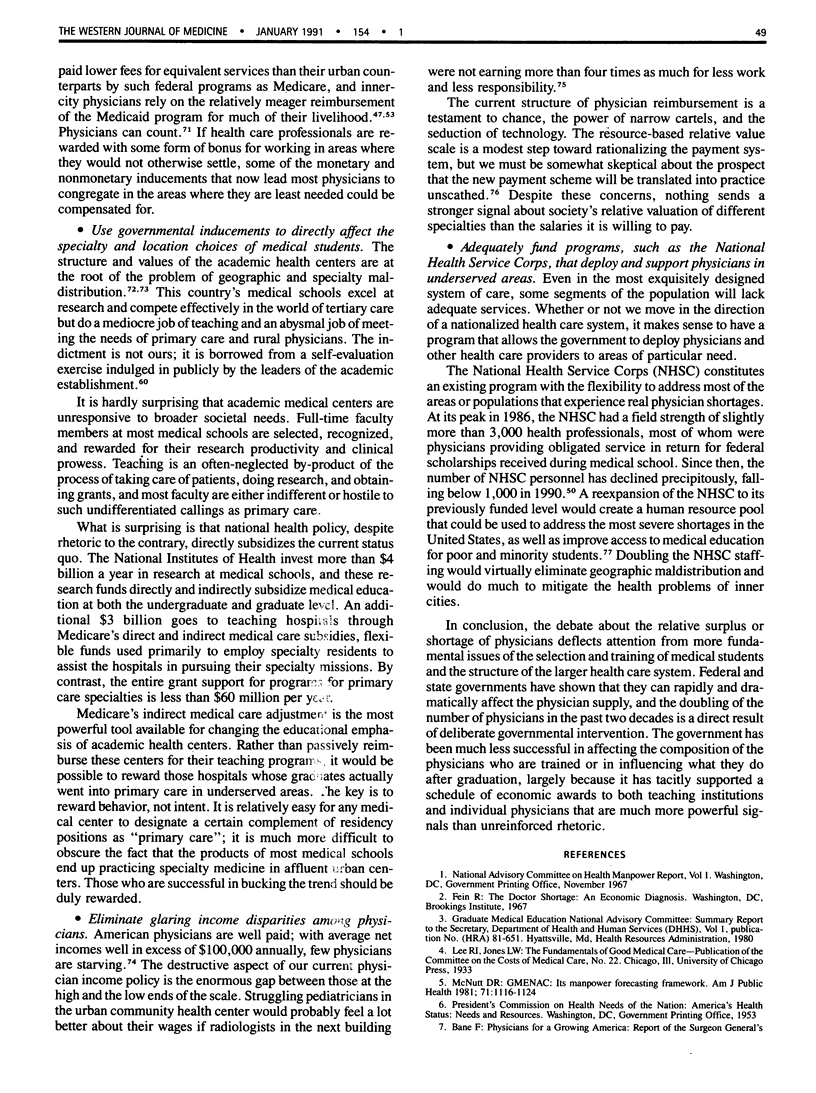
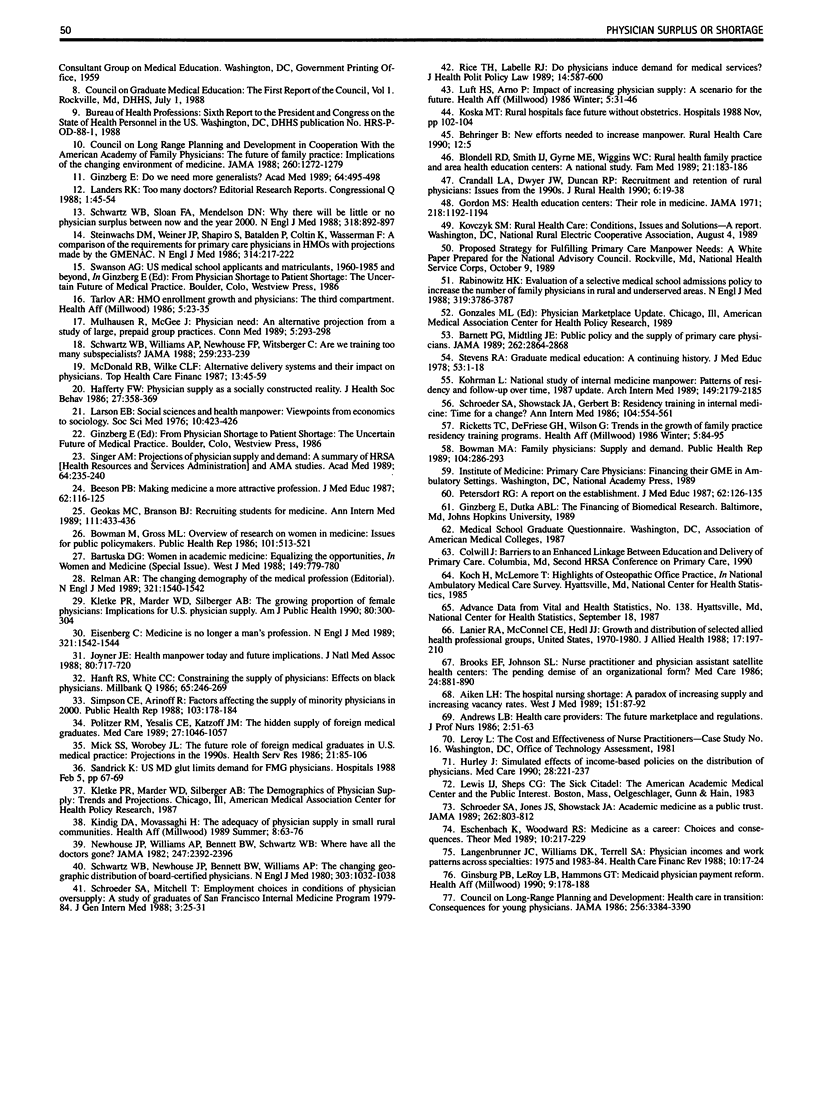
Selected References
These references are in PubMed. This may not be the complete list of references from this article.
- Aiken L. H. The hospital nursing shortage. A paradox of increasing supply and increasing vacancy rates. West J Med. 1989 Jul;151(1):87–92. [PMC free article] [PubMed] [Google Scholar]
- Andrews L. N. Health care providers: the future marketplace and regulations. J Prof Nurs. 1986 Jan-Feb;2(1):51–63. doi: 10.1016/s8755-7223(86)80087-4. [DOI] [PubMed] [Google Scholar]
- Barnett P. G., Midtling J. E. Public policy and the supply of primary care physicians. JAMA. 1989 Nov 24;262(20):2864–2868. [PubMed] [Google Scholar]
- Bartuska D. G. Women in academic medicine. Equalizing the opportunities. West J Med. 1988 Dec;149(6):779–780. [PMC free article] [PubMed] [Google Scholar]
- Beeson P. B. John A. D. Cooper lecture. Making medicine a more attractive profession. J Med Educ. 1987 Feb;62(2):116–125. doi: 10.1097/00001888-198702000-00006. [DOI] [PubMed] [Google Scholar]
- Blondell R. D., Smith I. J., Byrne M. E., Higgins C. W. Rural health, family practice, and area health education centers: a national study. Fam Med. 1989 May-Jun;21(3):183–186. [PubMed] [Google Scholar]
- Bowman M. A. Family physicians: supply and demand. Public Health Rep. 1989 May-Jun;104(3):286–293. [PMC free article] [PubMed] [Google Scholar]
- Bowman M., Gross M. L. Overview of research on women in medicine--issues for public policymakers. Public Health Rep. 1986 Sep-Oct;101(5):513–521. [PMC free article] [PubMed] [Google Scholar]
- Brooks E. F., Johnson S. L. Nurse practitioner and physician assistant satellite health centers. The pending demise of an organizational form? Med Care. 1986 Oct;24(10):881–890. doi: 10.1097/00005650-198610000-00002. [DOI] [PubMed] [Google Scholar]
- Crandall L. A., Dwyer J. W., Duncan R. P. Recruitment and retention of rural physicians: issues for the 1990s. J Rural Health. 1990 Jan;6(1):19–38. doi: 10.1111/j.1748-0361.1990.tb00188.x. [DOI] [PubMed] [Google Scholar]
- Eisenberg C. Medicine is no longer a man's profession. Or, when the men's club goes coed it's time to change the regs. N Engl J Med. 1989 Nov 30;321(22):1542–1544. doi: 10.1056/NEJM198911303212210. [DOI] [PubMed] [Google Scholar]
- Eschenbach K., Woodward R. S. Medicine as a career: choices and consequences. Theor Med. 1989 Sep;10(3):217–229. doi: 10.1007/BF00489440. [DOI] [PubMed] [Google Scholar]
- Geokas M. C., Branson B. J. Recruiting students for medicine. Ann Intern Med. 1989 Sep 1;111(5):433–436. doi: 10.7326/0003-4819-111-5-433. [DOI] [PubMed] [Google Scholar]
- Ginsburg P. B., LeRoy L. B., Hammons G. T. Medicare physician payment reform. Health Aff (Millwood) 1990 Spring;9(1):178–188. doi: 10.1377/hlthaff.9.1.178. [DOI] [PubMed] [Google Scholar]
- Ginzberg E. Do we need more generalists? Acad Med. 1989 Sep;64(9):495–497. doi: 10.1097/00001888-198909000-00001. [DOI] [PubMed] [Google Scholar]
- Gordon M. S. Health education centers. Their role in medical education. JAMA. 1971 Nov 22;218(8):1192–1194. [PubMed] [Google Scholar]
- Hafferty F. W. Physician oversupply as a socially constructed reality. J Health Soc Behav. 1986 Dec;27(4):358–369. [PubMed] [Google Scholar]
- Hanft R. S., White C. C. Constraining the supply of physicians: effects on black physicians. Milbank Q. 1987;65 (Suppl 2):249–269. [PubMed] [Google Scholar]
- Hurley J. Simulated effects of incomes-based policies on the distribution of physicians. Med Care. 1990 Mar;28(3):221–238. doi: 10.1097/00005650-199003000-00003. [DOI] [PubMed] [Google Scholar]
- Joyner J. E. Health manpower today and future implications. J Natl Med Assoc. 1988 Jul;80(7):717–720. [PMC free article] [PubMed] [Google Scholar]
- Kindig D. A., Movassaghi H. The adequacy of physician supply in small rural counties. Health Aff (Millwood) 1989 Summer;8(2):63–76. doi: 10.1377/hlthaff.8.2.63. [DOI] [PubMed] [Google Scholar]
- Kletke P. R., Marder W. D., Silberger A. B. The growing proportion of female physicians: implications for US physician supply. Am J Public Health. 1990 Mar;80(3):300–304. doi: 10.2105/ajph.80.3.300. [DOI] [PMC free article] [PubMed] [Google Scholar]
- Kohrman C. H., Lyttle C. S., Andersen R. M., Levey G. S. National Study of Internal Medicine Manpower. XIV: Patterns of residency and fellowship over time, 1987 update. Arch Intern Med. 1989 Oct;149(10):2179–2185. [PubMed] [Google Scholar]
- Koska M. T. Rural hospitals face future without obstetrics. Hospitals. 1988 Jun 5;62(11):102–104. [PubMed] [Google Scholar]
- Langenbrunner J. C., Williams D. K., Terrell S. A. Physician incomes and work patterns across specialties: 1975 and 1983-84. Health Care Financ Rev. 1988 Winter;10(2):17–24. [PMC free article] [PubMed] [Google Scholar]
- Lanier R. A., McConnel C. E., Hedl J. J. Growth and distribution of selected allied health professional groups, United States, 1970-1980. J Allied Health. 1988 Aug;17(3):197–210. [PubMed] [Google Scholar]
- Luft H. S., Arno P. Impact of increasing physician supply: a scenario for the future. Health Aff (Millwood) 1986 Winter;5(4):31–46. doi: 10.1377/hlthaff.5.4.31. [DOI] [PubMed] [Google Scholar]
- McDonald R. B., Wilke C. L. Alternative delivery systems and their impact on physicians. Top Health Care Financ. 1987 Spring;13(3):47–59. [PubMed] [Google Scholar]
- McNutt D. R. GMENAC: its manpower forecasting framework. Am J Public Health. 1981 Oct;71(10):1116–1124. doi: 10.2105/ajph.71.10.1116. [DOI] [PMC free article] [PubMed] [Google Scholar]
- Mick S. S., Worobey J. L. The future role of foreign medical graduates in U.S. medical practice: projections into the 1990s. Health Serv Res. 1986 Apr;21(1):85–106. [PMC free article] [PubMed] [Google Scholar]
- Newhouse J. P., Williams A. P., Bennett B. W., Schwartz W. B. Where have all the doctors gone? JAMA. 1982 May 7;247(17):2392–2396. [PubMed] [Google Scholar]
- Petersdorf R. G. A report on the establishment. J Med Educ. 1987 Feb;62(2):126–135. doi: 10.1097/00001888-198702000-00007. [DOI] [PubMed] [Google Scholar]
- Politzer R. M., Yesalis C. E., Katzoff J. M. The hidden future supply of foreign medical graduates. Med Care. 1989 Nov;27(11):1046–1057. doi: 10.1097/00005650-198911000-00006. [DOI] [PubMed] [Google Scholar]
- Relman A. S. The changing demography of the medical profession. N Engl J Med. 1989 Nov 30;321(22):1540–1542. doi: 10.1056/NEJM198911303212209. [DOI] [PubMed] [Google Scholar]
- Rice T. H., Labelle R. J. Do physicians induce demand for medical services? J Health Polit Policy Law. 1989 Fall;14(3):587–600. doi: 10.1215/03616878-14-3-587. [DOI] [PubMed] [Google Scholar]
- Ricketts T. C., DeFriese G. H., Wilson G. Trends in the growth of family practice residency training programs. Health Aff (Millwood) 1986 Winter;5(4):84–96. doi: 10.1377/hlthaff.5.4.84. [DOI] [PubMed] [Google Scholar]
- Sandrick K. U.S. MD glut limits demand for FMG physicians. Hospitals. 1988 Feb 5;62(3):67–69. [PubMed] [Google Scholar]
- Schroeder S. A., Mitchell T. Employment choices in conditions of physician oversupply: a study of graduates of San Francisco internal medicine programs, 1979-1984. J Gen Intern Med. 1988 Jan-Feb;3(1):25–31. doi: 10.1007/BF02595753. [DOI] [PubMed] [Google Scholar]
- Schroeder S. A., Showstack J. A., Gerbert B. Residency training in internal medicine: time for a change? Ann Intern Med. 1986 Apr;104(4):554–561. doi: 10.7326/0003-4819-104-4-554. [DOI] [PubMed] [Google Scholar]
- Schroeder S. A., Zones J. S., Showstack J. A. Academic medicine as a public trust. JAMA. 1989 Aug 11;262(6):803–812. [PubMed] [Google Scholar]
- Schwartz W. B., Newhouse J. P., Bennett B. W., Williams A. P. The changing geographic distribution of board-certified physicians. N Engl J Med. 1980 Oct 30;303(18):1032–1038. doi: 10.1056/NEJM198010303031803. [DOI] [PubMed] [Google Scholar]
- Schwartz W. B., Sloan F. A., Mendelson D. N. Why there will be little or no physician surplus between now and the year 2000. N Engl J Med. 1988 Apr 7;318(14):892–897. doi: 10.1056/NEJM198804073181405. [DOI] [PubMed] [Google Scholar]
- Schwartz W. B., Williams A. P., Newhouse J. P., Witsberger C. Are we training too many medical subspecialists? JAMA. 1988 Jan 8;259(2):233–239. [PubMed] [Google Scholar]
- Simpson C. E., Jr, Aronoff R. Factors affecting the supply of minority physicians in 2000. Public Health Rep. 1988 Mar-Apr;103(2):178–184. [PMC free article] [PubMed] [Google Scholar]
- Singer A. M. Projections of physician supply and demand: a summary of HRSA and AMA studies. Acad Med. 1989 May;64(5):235–240. doi: 10.1097/00001888-198905000-00003. [DOI] [PubMed] [Google Scholar]
- Steinwachs D. M., Weiner J. P., Shapiro S., Batalden P., Coltin K., Wasserman F. A comparison of the requirements for primary care physicians in HMOs with projections made by the GMENAC. N Engl J Med. 1986 Jan 23;314(4):217–222. doi: 10.1056/NEJM198601233140406. [DOI] [PubMed] [Google Scholar]
- Stevens R. A. Graduate medical education: a continuing history. J Med Educ. 1978 Jan;53(1):1–18. [PubMed] [Google Scholar]
- Tarlov A. R. HMO enrollment growth and physicians: the third compartment. Health Aff (Millwood) 1986 Spring;5(1):23–35. doi: 10.1377/hlthaff.5.1.23. [DOI] [PubMed] [Google Scholar]


